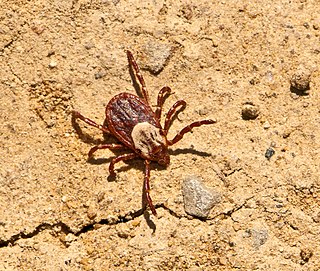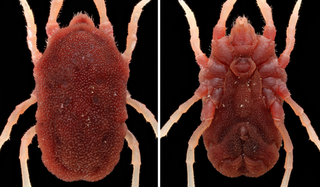
Rickettsia is a genus of nonmotile, Gram-negative, nonspore-forming, highly pleomorphic bacteria that may occur in the forms of cocci, bacilli, or threads. The term "rickettsia" has nothing to do with rickets ; the bacterial genus Rickettsia was named after Howard Taylor Ricketts, in honor of his pioneering work on tick-borne spotted fever.

Rocky Mountain spotted fever (RMSF) is a bacterial disease spread by ticks. It typically begins with a fever and headache, which is followed a few days later with the development of a rash. The rash is generally made up of small spots of bleeding and starts on the wrists and ankles. Other symptoms may include muscle pains and vomiting. Long-term complications following recovery may include hearing loss or loss of part of an arm or leg.

Rickettsia rickettsii is a Gram-negative, intracellular, coccobacillus bacterium that is around 0.8 to 2.0 μm long. R. rickettsii is the causative agent of Rocky Mountain spotted fever. R. rickettsii is one of the most pathogenic Rickettsia strains. It affects a large majority of the Western Hemisphere and small portions of the Eastern Hemisphere.
Tick-borne diseases, which afflict humans and other animals, are caused by infectious agents transmitted by tick bites. They are caused by infection with a variety of pathogens, including rickettsia and other types of bacteria, viruses, and protozoa. Because individual ticks can harbor more than one disease-causing agent, patients can be infected with more than one pathogen at the same time, compounding the difficulty in diagnosis and treatment. 16 tick-borne diseases of humans are known, of which four have been discovered since 2013.
Relapsing fever is a vector-borne disease caused by infection with certain bacteria in the genus Borrelia, which is transmitted through the bites of lice or soft-bodied ticks.

Ixodes is a genus of hard-bodied ticks. It includes important disease vectors of animals and humans, and some species inject toxins that can cause paralysis. Some ticks in this genus may transmit the pathogenic bacterium Borrelia burgdorferi responsible for causing Lyme disease. Additional organisms that may be transmitted by Ixodes are parasites from the genus Babesia, which cause babesiosis, and bacteria from the related genus Anaplasma, which cause anaplasmosis.

Ixodes ricinus, the castor bean tick, is a chiefly European species of hard-bodied tick. It may reach a length of 11 mm (0.43 in) when engorged with a blood meal, and can transmit both bacterial and viral pathogens such as the causative agents of Lyme disease and tick-borne encephalitis.

Rhipicephalus sanguineus, commonly called the brown dog tick, kennel tick, or pantropical dog tick, is a species of tick found worldwide, but more commonly in warmer climates. This species is unusual among ticks in that its entire lifecycle can be completed indoors. The brown dog tick is easily recognized by its reddish-brown color, elongated body shape, and hexagonal basis capituli. Adults are 2.28 to 3.18 mm in length and 1.11 to 1.68 mm in width. They do not have ornamentation on their backs.

Rickettsia conorii is a Gram-negative, obligate intracellular bacterium of the genus Rickettsia that causes human disease called boutonneuse fever, Mediterranean spotted fever, Israeli tick typhus, Astrakhan spotted fever, Kenya tick typhus, Indian tick typhus, or other names that designate the locality of occurrence while having distinct clinical features. It is a member of the spotted fever group and the most geographically dispersed species in the group, recognized in most of the regions bordering on the Mediterranean Sea and Black Sea, Israel, Kenya, and other parts of North, Central, and South Africa, and India. The prevailing vector is the brown dog tick, Rhipicephalus sanguineus. The bacterium was isolated by Emile Brumpt in 1932 and named after A. Conor, who in collaboration with A. Bruch, provided the first description of boutonneuse fever in Tunisia in 1910.

Dermacentor is a genus of ticks in the family Ixodidae, the hard ticks. The genus has a cosmopolitan distribution, with native species on all continents except Australia. Most occur in the Nearctic realm.
Rickettsia australis is a bacterium that causes a medical condition called Queensland tick typhus. The probable vectors are the tick species, Ixodes holocyclus and Ixodes tasmani. Small marsupials are suspected reservoirs of this bacterium.

Ornithodoros is a genus in the soft-bodied tick family, Argasidae.
Rickettsia felis is a species of bacterium, the pathogen that causes cat-flea typhus in humans. In cats the disease is known as flea-borne spotted fever. Rickettsia felis also is regarded as the causative organism of many cases of illnesses generally classed as fevers of unknown origin in humans in Africa.

Ornithodoros hermsi is a species of soft tick. It can be infected with Borrelia hermsii.
Borrelia duttoni, formerly known as Spirochaeta duttoni, is a species of Borrelia.

Ornithodoros moubata, commonly known as the African hut tampan or the eyeless tampan, is a species of tick in the family Argasidae. It is an ectoparasite and vector of relapsing fever in humans, and African swine fever in pigs.

Ornithodoros turicata, commonly referred to as the relapsing fever tick, is a soft tick found in the midwestern and southwestern United States. It is a known vector of Borrelia turicatae, a spirochete responsible for tick-borne relapsing fever in humans. Additionally, vector competence for the transmission of Leptospira pomona, the agent of canine jaundice, has been demonstrated in a laboratory setting.

Robert Allen Cooley was a US entomologist. Born in Deerfield, Massachusetts, he studied at Massachusetts Agricultural College and worked at Montana State College. He was appointed the first state entomologist for Montana in 1903, and worked on Rocky Mountain spotted fever, studying the life cycle of the tick that transmits the Rickettsia bacteria that cause the disease. He also worked on the eradication of the disease and from 1931 until his retirement in 1946 was head entomologist at the Rocky Mountain Laboratory, Hamilton, Montana, where the vaccine was developed. Cooley died at the age of 95 in Hamilton. The Cooley Laboratory at Montana State University is named in his honour.

Otobius is a genus in the soft-bodied tick family, Argasidae. While similar to the genus Ornithodoros it is characterized by a vestigial hypostome in adults, despite being developed in nymphs, in addition to the absence of both eyes and hood.













